Swamp tea tree is a common name for several plants and may refer to:
- Melaleuca dealbata
- Melaleuca irbyana
- Pericalymma ellipticum , endemic to Western Australia
Swamp tea tree is a common name for several plants and may refer to:
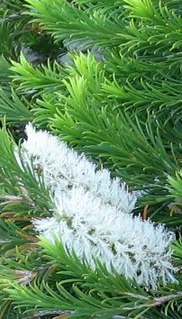
Melaleuca is a genus of nearly 300 species of plants in the myrtle family, Myrtaceae, commonly known as paperbarks, honey-myrtles or tea-trees. They range in size from small shrubs that rarely grow to more than 16 m (52 ft) high, to trees up to 35 m (115 ft). Their flowers generally occur in groups, forming a "head" or "spike" resembling a brush used for cleaning bottles, containing up to 80 individual flowers.
Mohan may refer to:
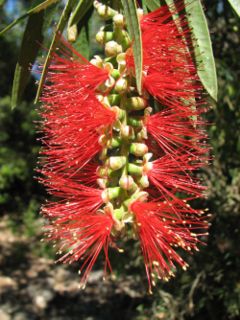
Callistemon is a genus of shrubs in the family Myrtaceae, first described as a genus in 1814. The entire genus is endemic to Australia but widely cultivated in many other regions and naturalised in scattered locations. Their status as a separate taxon is in doubt, some authorities accepting that the difference between callistemons and melaleucas is not sufficient for them to be grouped in a separate genus.
Snow-in-summer is a common name or term used for several different plants, namely those that have showy clusters of white-coloured flowers which bloom in summer or late spring:
A totem pole is a Indigenous, Native American artifact.

Melaleuca quinquenervia, commonly known as the broad-leaved paperbark, paper bark tea tree, punk tree or niaouli, is a small- to medium-sized tree of the myrtle family, Myrtaceae. It grows as a spreading tree up to 20 m (70 ft) tall, with its trunk covered by a white, beige and grey thick papery bark. The grey-green leaves are egg-shaped, and cream or white bottlebrush-like flowers appear from late spring to autumn. It was first formally described in 1797 by the Spanish naturalist Antonio José Cavanilles.
Melaleuca is a plant genus in the family Myrtaceae containing the paperbarks.

Melaleuca leucadendra, commonly known as weeping paperbark, long-leaved paperbark or white paperbark is a plant in the myrtle family, Myrtaceae and is widespread in northern Australia, Southeast Asia, New Guinea and the Torres Strait Islands. It is a tree, sometimes growing to more than 20 m (70 ft) with a trunk covered with thick, white, papery bark and weeping thinner branches. It has a long flowering season, can flower at almost any time of the year and is often grown as a tree in parks and on roadsides. It was the first melaleuca to be described and was described from a specimen growing in Indonesia.
Narrow-leaved paperbark is a common name used to describe several species of flowering plants in the genus Melaleuca:
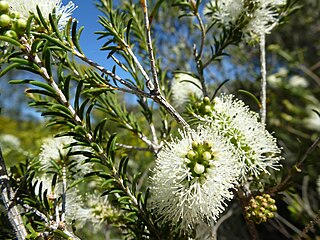
Melaleuca rhaphiophylla, commonly known as swamp paperbark is a plant in the myrtle family, Myrtaceae and is endemic to the south west of Western Australia. It has narrow, needle-like leaves and profuse spikes of white or yellowish flowers at variable times throughout the year. As its common name suggests, it is usually found in salt marshes, or swamps or along watercourses and occurs over wide areas of the south-west.

Melaleuca lanceolata commonly known as black paperbark, moonah, Rottnest Island teatree and western black tea tree is a plant in the myrtle family, Myrtaceae and is native to Australia where it occurs in Western Australia, South Australia, Victoria, New South Wales and Queensland. It is a densely foliaged tree with rough bark, which flowers prolifically in summer.
Camphorweed is a common name for several plants and may refer to:
Broom bush may refer to:
Swamp paperbark is a common name for several plants and may refer to:
Lyndley Alan Craven was a botanist who became the Principal Research Scientist of the Australian National Herbarium.

Melanoleuca melaleuca is a species of mushroom in the family Tricholomataceae, and it is the type species of its genus Melanoleuca. It is difficult to distinguish from other related species firstly because it is variable, secondly because the taxonomic criteria are often based on characteristics which have later been found to be variable, and thirdly because there is much disagreement between authorities as to exactly how the species should be defined.

Oxyops vitiosa is a species of weevil in the family Curculionidae. Common names include the melaleuca leaf weevil and the melaleuca snout beetle. It feeds on the leaves and shoots of the broad-leaved paper bark tree, Melaleuca quinquenervia, which is endemic to Australia where it grows on seasonally inundated plains and swampland, and was introduced into Florida in order to help drain flooded portions of the Everglades.
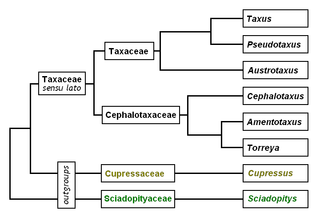
Yew is a common name given to various species of trees.
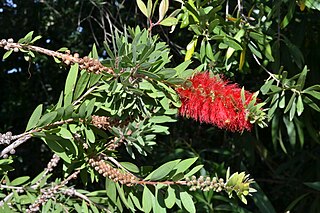
Melaleuca citrina, the common red bottlebrush, crimson bottlebrush, or lemon bottlebrush, is a plant in the myrtle family Myrtaceae, and is endemic to eastern Australia. Some Australian state herbaria continue to use the name Callistemon citrinus. It is a hardy and adaptable species, common in its natural habitat. It is widely cultivated, not only in Australia. It was one of the first Australian plants to be grown outside the country, having been taken to England in 1770 by Joseph Banks. Its showy red flower spikes, present over most of the year in an ideal situation, account for its popularity.
M. concinna may refer to: